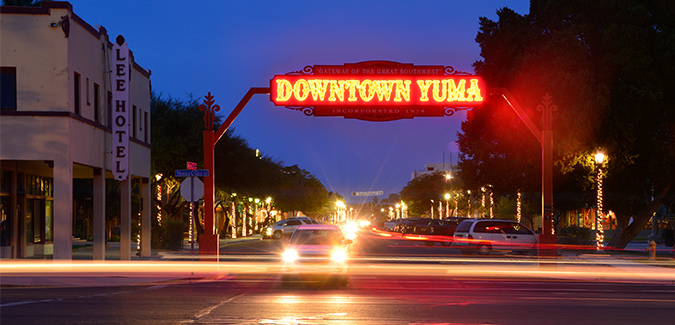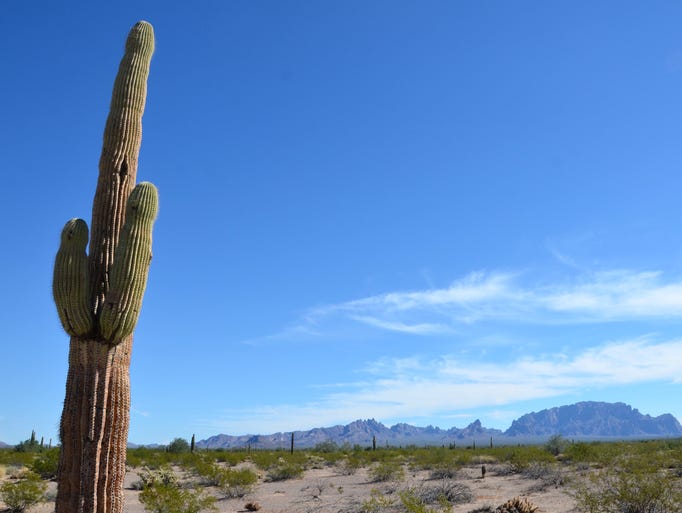
You might say to yourself, Yuma? Yes, Yuma – because it’s how my road trip started on a trip to Lake Havasu earlier this year. I suddenly found out that one of my gigs was postponed a couple of days, so I decided to head south to hit some ghost towns and two-lane highways I’d never been to before – really dig into the authentic Old West. After all, “3:10 to Yuma,” the classic Western, was filmed there, right?
Located in the southwest corner of Arizona, Yuma County is known as the “Winter Vegetable Capital of the World.” With more than 300 sunny days each year, wintertime in and around Yuma is a great time for a road trip.
I start in Quartzsite, Ariz., “The Rock Capital of the World,” just about 140 miles from the Coachella Valley on Interstate 10. Quartzsite isn’t much more than a crossroads town for most of the year with a few truck stops and gas stations, but in the winter it is a paradise for rock hounds – more than 1 million visitors (typically snowbirds in their RVs) and more than 1,000 rock, gem and fossil vendors turn the town into one of the world’s largest flea markets. Check out Reader’s Oasis Books, a second-hand shop known as the “naked man’s bookstore,” where owner Paul Winer sells about 200,000 titles in a G-string.
Heading south on State Route 95, Quartzsite disappears behind me and saguaro begin to appear as I enter Kofa National Wildlife Refuge. There are several paved roads leading off the highway into the mountains that are just begging to be explored. Hiking and camping also are allowed.
Located just about 40 miles north of Yuma on the south end of the refuge, you’ll pass a sign for Castle Dome City and Museum. Don’t mind the graded dirt road, as it happens to lead to one of the best ghost towns I have ever visited. Sitting at the base of Castle Dome Mountains, you’ll find a fine example of an 1878 mining town that was once larger than Yuma. There are more than 50 restored buildings to explore – many of them original to the town and full of artifacts. Plus, there is a cool gift store when you enter, where drinks and snacks are sold.
Entering Yuma from Interstate 8, I make my way into historic downtown for something to eat on Main Street, which looks straight out of the old days. My first stop is Lutes Casino. You can’t gamble here anymore, but the bar and restaurant are pretty funky. Every wall is covered in memorabilia, from vintage posters to neon signs and mannequins. The specialty here is the Lutes Especial burger – a signature since 1951. It’s a cheeseburger topped with three grilled hot dog halves – really pretty good! The rest of the menu has other fun stuff like Chili Fritos and a vegetarian burger, as well as Mexican dishes and ice cold beer.
After lunch, I walk around downtown and find several antique and thrift stores along the main drag. One in particular, Timeless Elegance, is huge and is curated in sections by color or item. I spend a good hour here and still don’t get to see it all. The prices are way less than any other place I’ve found in my travels, and it reminds me of a store that I always stop by on tour in Austin called Uncommon Objects. I can’t wait to come back. Even a few dive bars catch my eye.
My next stop is Yuma Territorial Prison, probably the most famous place to visit in town. The prison, built by inmates, opened in 1876 and closed in 1909. Now a state park and museum, it held some of the roughest and toughest Wild West outlaws, both men and women. There is an excellent exhibit in the main hall with mugshots of all the inmates. With freestanding cells built pretty much of solid rock, it’s tough to imagine how harsh doing time here in the dead of summer must have been like. A couple of the cells are haunted, I’m told by the ranger who works in the gift and bookstore, and sometimes the prison does ghost tours – definitely worth checking out.
Down the road from the prison and also part of the state park system is the Yuma Quartermaster Depot. Established in 1864, the depot supplied frontier Army posts in Texas, Nevada, New Mexico and Utah. Located on the banks of the Colorado River, there are several original buildings to tour that detail the history of the depot. There is also an excellent visitor’s center and bookstore at the entrance. I learned a bit more about Yuma from one of the docents, and I got a recommendation for where I end up staying the night: the Historic Coronado Motor Hotel.
The hotel has been owned by the same family since 1938 and was one of the first Best Westerns in the state of Arizona. Originally built as 14 rooms, it has since expanded to the other side of the street but the original inn keeper’s home and office is now a museum. Ask the owner, Yvonne Peach, for a tour – it’s well worth it. There is even a suite that Bob Hope stayed in every year when he came to town to entertain local troops. The rooms are cozy and old school, a great place to rest up. There are several other chain hotels along the interstate to choose from as well. For breakfast, I walk next door to the Yuma Landing Bar & Grill. The food is great but the real attraction is the history. The first airplane landing in the state of Arizona happened in 1911 at this spot, and every wall is covered with pictures and artifacts that chronicle the history of Yuma.
Heading back to California, I exit the freeway about 10 minutes from Yuma to go to Los Algodones, Mexico – just 2 miles down the road. This small border town is known for its medical tourism, and thousands of snowbirds park their cars and walk across the border every day to see the town’s dozens of dentists, optometrists and pharmacies. I’ve come to get a new pair of glasses and by the end of my visit, I’m able to get my eyes tested plus a new pair of progressive lenses for way cheaper than in the U.S. The hour or two that they need to make them is just enough time buy an awesome blanket, bottle of tequila and a snack – there are lots of curio shops, as this town is built for tourists. Be sure to bring along your passport. There is a large, secure parking lot with ATMs on the U.S. side, and the cost is about $10 per day.
With my new glasses I can see where I’m going next, so I head west on Interstate 8 for a couple of miles to Felicity, Calif., the Official Center of the World. Yes, you read that right: This a classic roadside attraction that is not be missed. Pay a fee in the gift shop to gain access to the granite pyramid that houses the mark of the center, and then tour the history of the humanity etched into granite walls behind the pyramid. You honestly have to see it to believe it. A few cool facts: the spiral metal staircase you pass as you drive in is an original section from the Eiffel Tower, and the arm on the giant sundial is a replica of Michelangelo’s “Arm of God.” An odd but interesting place. And the best part? All of it is only a road trip away.






